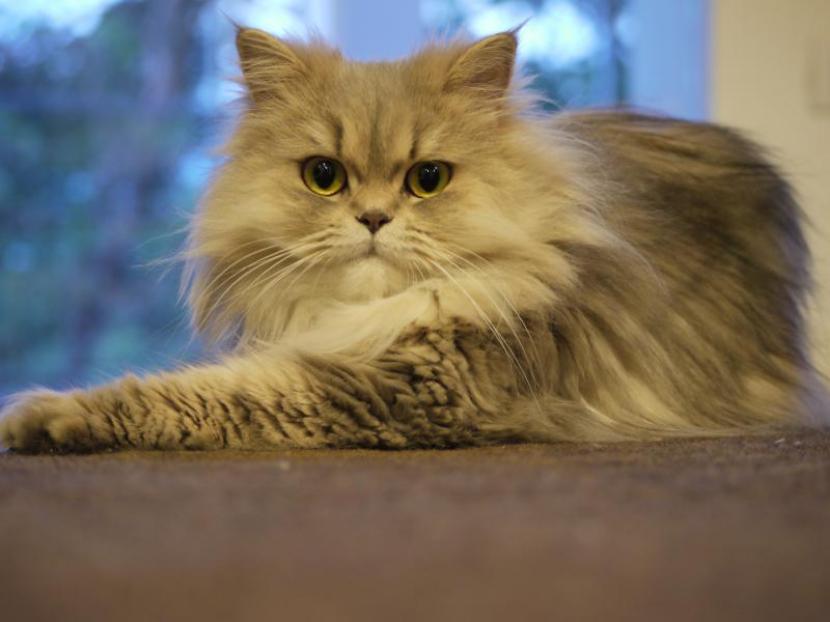
El Persian cat is the Lord of the Cats. Very elegant, aristocratic. It is an animal with history. It has a very special character and a look that has already seduced millions of people around the world; maybe it will melt your heart sooner than you imagine. In addition, he is very sociable, but it is a type of sociability typical of his race.
As we know you love it, we bring you a super post about the Persian cat, where you can find absolutely everything what you should know: its origin, character, health, behavior, ... and much, much more. Do not miss it.
Download the ebook of The Persian cat for FREE
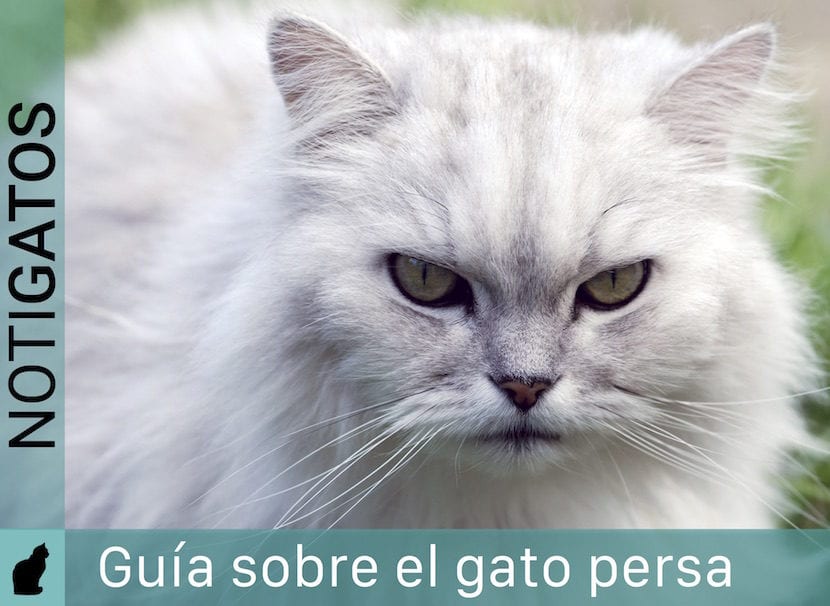
This article is very extensive, we have created it in order to have a complete guide on the Persian cat. In order to make it easier to read and so that you can archive it in your library, we have put together an ebook in pdf format. Download it for free by clicking on the following link:
Origin of the Persian cat
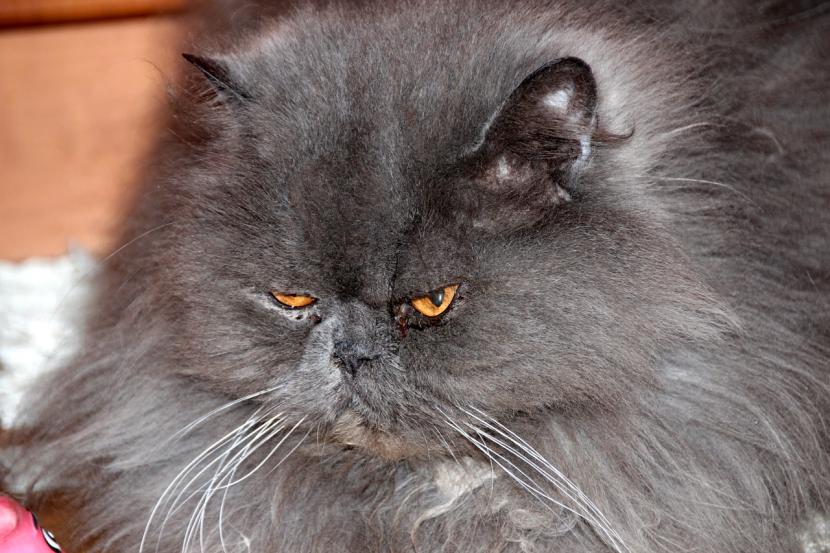
It is not well known when the long-haired cats appeared. And it is that the only felines that had the gene that ensures that the fur is long are the lynx and the snow leopard, and as far as is known, the felis catus she has never crossed paths with either of them. What can be said for sure is that appeared for the first time in what is today Iran (Formerly it was called Persia). From there the Italian Pietro Della Valle (1586-1652) took several cats that had long hair and brought them to Italy in the year 1620. Some years later, Nicolas-Claude Fabri de Peiresc, naturalist and scholar, brought cats from long hair from present-day Ankara (ancient Angora) in Turkey, to France. Until now, it has not been possible to find out if all these cats were of the same breed.
Why does a cat have long hair in a climate as hot as some countries like Iran have? Surely you have ever wondered, since nature endows animals that live in cold climates with long hair, with very intense frosts. Well, there are several theories:
- One says that some ancestors of the Persian cat they had long hair as they believe, they were originally from Siberia. Later they were introduced in Asia, and later in Western Europe.
- The second theory says that long hair was nothing more than a mutation that happened to the shorthair cat that lived in the East. This gene could have been maintained thanks to domestication and the selection of cats to breed them.
- And the third believes that phenotypic differences of Persians and domesticsi.e. round face, broad ears, robust body, are related to Pallas's cat. This is a wild cat that lives in Central Asia, it has relatively long hair, a flat face, round eyes and lowered ears.
While they are very different theories, they all point to places in Asia. But it was not there that the selection and breeding process began, but in England. In fact, it is the 'second homeland' of the Persian cat, since already in the XNUMXth century these cats had many followers. Back then the characteristics of the Asian longhair cat began to differ from those of the Persian cat. But it is very curious because only the blue cats were called 'Persian'; even today what we call Persian, for them is a 'long-haired' cat. Each color variation corresponds to a different breed.
Since breeding began to date, they have seemed 150 variations. Many breeders, especially from the United States of America, spent time producing offspring with a more rounded head, a wider and more robust body, and a flatter snout. From 1920 until now they continue to breed them, although there are veterinarians who think that a cat with these characteristics can have many problems breathing. In spite of everything, in the USA and in many European countries, the 'extreme Persian cats', as they are called, are very popular.
The contemporary Persian cat has been the exotic cat parent. A short-haired breed that has all the traits of the Persian except the length of its hair. This new breed was created in the United States in the 60s, and was recognized in 1984. With a semi-long coat, very shiny, it is, like the Persian, a very special cat.
But let's not deviate 🙂. Let's now see the classification of the Persian cat.
Classification
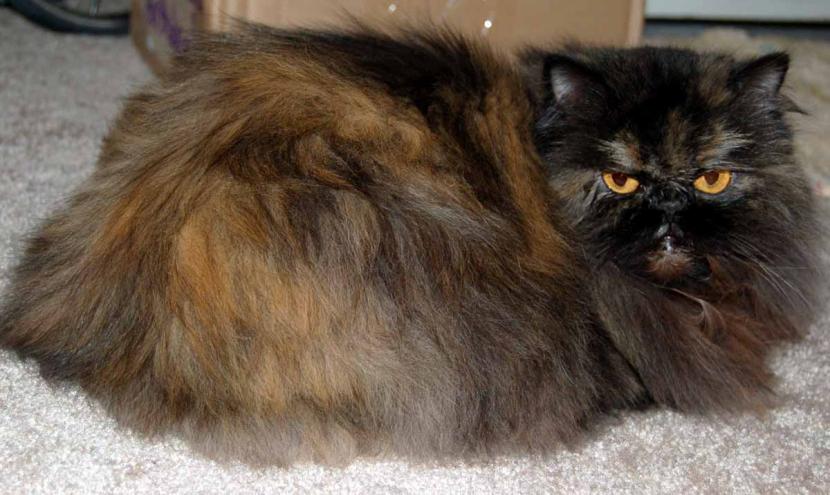
There are more than 100 varieties of Persian cats, so it is undoubtedly the breed that presents the most variety of colors (white, black, bicolor ...). As there are so many, four groups have been made, so it is much easier to classify them. Each of them is different from the rest, but all are determined according to the way in which these colors are distributed and according to the genes involved.
Thus, we have:
Monochrome
Here would enter all the Persian cats that they only have a single color, either solid or diluted: black, blue, lilac, red, cream, chocolate, white, bicolor, tricolor.
Gene I
If your Persian cat has part of its hair depigmented, it is because it has the Inhibitor gene (gene I). According to the color ratio, Persian cats are distinguished chinchillas (shell), shaded (shaded) or smoked (smoke). Thus we have:
Chinchillas
- cameo: are white with red depigmentation
- cream: who have cream-colored depigmentation
- blue-cream: blue cat with cream-colored depigmentation
Shaded
- golden: that are golden with a reddish background
- silver: that are white, with silvery depigmentation
Smoked
- tricolor: Persians that have a solid color background, but three different colors are clearly distinguished on the back and head.
- black smoke tortie: these Persians have a coat of different shades of gray and black. Their necks may be white.
Gene C
The C gene comes from Siamese cats, which also provides our protagonists with a stronger color density in their tail, ears, nose and the pins.
Gene A
The Agouti gene (gene A) makes wild marks visible of the cat. It can be combined with the previous genes. According to the color, seven divisions are distinguished:
- Color dots or color point
- Solid colors or solid division
- Tabby or tabby
- Bicolor or bicolor
- Shadows and smoke, or shaded / smoke
- Silver and gold, or silver / golden
Standard
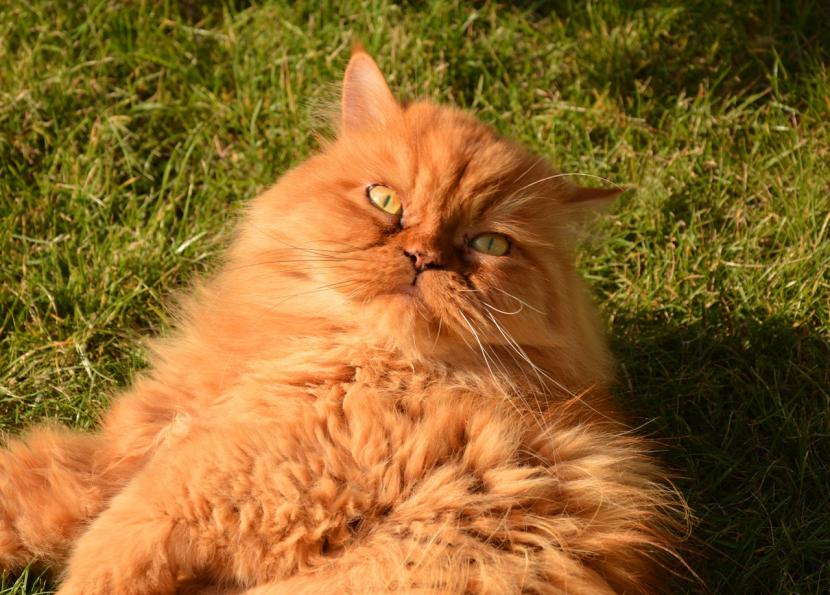
According to the CFA (Cat Fanciers' Association) we will know that we are dealing with a Persian cat if it shows these characteristics:
Head
The head, as we said, has to be round, with the wide skull. The structure of it has to be smooth and soft, not too exaggerated. The face must also be round, placed on a neck that has to be short and wide. When viewed in profile, the chin, nose, and forehead appear to be in vertical alignment.
Chin
Has to be well developed, rounded y full.
Cheeks
They must be full, with the snout well fitted between them.
Eyes
The eyes should be big, color bright, round. They will be far apart, but level.
Ears
They have to be small, With the rounded tip and base not too wide. They must be leaning forward, placed far apart and in a low position.
The Body
It must have low legs, a wide and deep chest. Robust physique, with good muscle tone.
Jaws
They have to be powerful and wide.
Pins
The front legs need to be straight, while the back legs will only be straight if viewed from the back. They also have to be wide and short.
Glue
If we talk about the tail, this it will be short, but well proportioned.
Claws
His toes (five on the front legs and 4 on the back) will be together. The claws will be large, firm and rounded.
Manto
This stuffed animal must of course have the long thick hair that covers the whole body, even the tail. Its fine and shiny texture will make you not want to stop stroking it.
Disqualifications
To avoid confusion, the CFA considers that it will not be a Persian cat if it exhibits:
- some deformity
- moles or small spots
- squinting eyes
- hindquarters weakness
- more or fewer fingers than you should have
CFA classification of the Persian cat
- Head - 30 points
- Body - 20 points
- Mantle - 10 points
- Balance - 5 points
- Refinement - 5 points
- Coat color - 20 points
- Eye color - 10 points
Behavior / character

The personality or rather, felinity, of the Persian cat is perfectly combined with that of those people who are calm. In fact, Persians are cats to whom they love to spend hours and hours lying on the couchSo much so that they are often known by such curious names as "leather furniture" or "sofa tigers." Unfortunately, if you are looking for a feline that is active, the Persian will not be a very good choice, although of course it will also have moments when it will want to play and run around, but not as they will be as frequent as they are, for example, for a flare or a common European cat.
Persians are very intelligent, and they know well who takes care of them. They can come to love this person very much, to whom they will not hesitate to ask for pampering and caresses ... but without going overboard. If they start to feel very uncomfortable, they will let you know. How? Very easy: most of the time they will just leave, but when they feel that they are being harassed they can snort, throw their ears back and, if the harassment continues, they can scratch and / or bite. Therefore, It is very important that we leave them alone, letting them come to us and not the other way around..
Otherwise, it is an ideal cat for people who live alone, also for those who are of advanced age, because although they need some care that we will see below, it is that responsibility that will make them feel useful, that they feel really alive and loved. Something that, after all, we all need, especially after a certain age. Although the Persian cat can also make the perfect cat for families or younger couples, as long as they are looking for a furry companion who is naturally calm.
The Persian cat is like a stuffed animal that loves to control its own day to day, and one of the few that will adapt seamlessly to living indoors, whether in a flat, apartment or house. And is that due to their docile temperament, they are considered indoor cats only, so you will not have to worry about anything. Although, yes, that does not mean that we do not have to leave it at home, only with food, water and a bed. It is a cat, a living being, that will need other kinds of attention, otherwise it will get bored and can cause damage like any other cat.
But if it is well cared for, it will be difficult for you to hear him meow. Many do not even make a sound, except when they are scared or when they feel unwell. In addition, they are very intelligent, so much so that they will learn very quickly where they should go to relieve themselves, and where is the best place to take a nap (normally, it will be next to the person they trust the most). And, as if that were not enough, if tomorrow you are going to increase your cat family, they usually accept their new partner without problems, but still it is important that you go little by little to avoid disappointments. To get them to become friends, you have to follow some socialization steps that will allow them to have a solid and lasting friendship relationship, they are the following:
How to get my Persian cat to get along with another cat
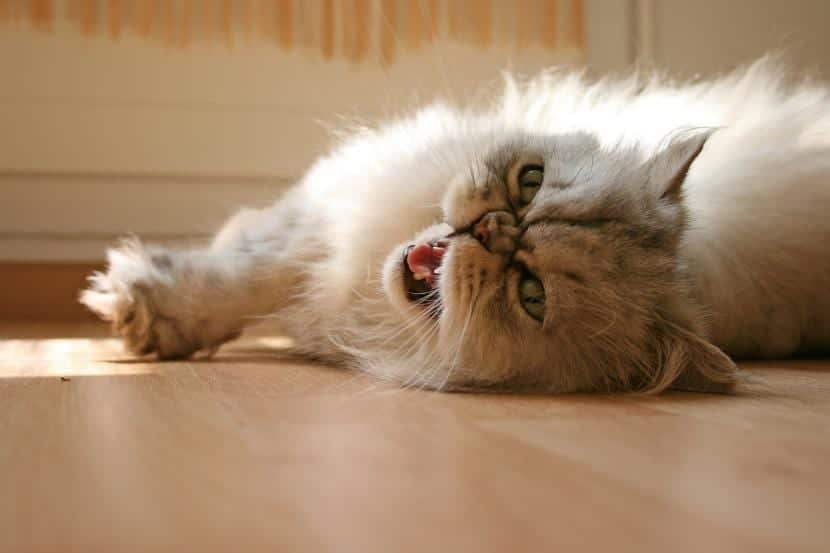
This precious Persian cat was caught when he was yawning
First phase
The first thing we have to do, first of all, is to introduce the new cat in the carrier and go home, where our Persian will surely be waiting for us. As soon as we open the door, it is highly advisable that we observe how both animals act: if one of them hisses and / or growls, we will immediately take the 'new one' to a room that we will have prepared for him with food, water, a bed and his own sand tray; otherwise, that is, if they are curious about each other, then we will leave the new cat still inside the carrier on the floor so they can smell each other. We will leave it for 5-10 minutes (we do not have to force the situation either) and we will take the new cat to the room. The next day, and for a week, we will repeat this same action every day, a couple of times until the new cat begins to show desire to go out and be with the Persian cat, and until he is more comfortable with your presence.
During this first phase it is normal that, although it seems that everything is going well, there is some other snort. But if the cats don't stick their claws out, and they approach each other with curiosity, no problem.
Second stage
Once the two animals feel good about each other, we can encourage ourselves (we, yes 🙂) to put them together, without carriers in between. Of course, I recommend that at least 2-3 days put them on both sides of a baby barrierIn this way, the two will have the same freedom of movement and will be able to do something that they will probably do a lot from now on: touch with their feet. And, the same, if there are no snorts or 'aggressive' behaviors, from the fourth day we can, now, remove the barrier and wait to see how they behave.
In this phase it is very important that let's be calmOtherwise the animals will notice and feel tense. If you find yourself feeling very nervous, have a lime or spend the previous 10 minutes doing breathing or relaxation exercises, or do something that calms you down. It may sound silly, a minor detail, but trust me, it works.
Third phase
In this third and final phase, your two cats will have at least tolerated each other. It is time to start living a normal life, with two beautiful furry friends. Of course, from time to time you will see that they snort, or even put themselves on top of each other as if they were fighting, but these behaviors are normal. What's more, you'll know they've gotten into trouble when:
- Roll your ears back, or forwards
- Show your teeth
- Keep your gaze fixed on your 'opponent'
- They huff and / or growl
- Keep the tail low, moving only the tip, or if you have it between the legs
If it were the case that one of the two was shown like this, it would be necessary to take it and move it away from the other cat, after which I would advise you to buy a Feliway brand diffuser. This product mimics feline pheromones, making them feel calmer and, therefore, calmer when they are with their furry companion.
The diffuser will turn on the room where the family makes more life, but it does not hurt to buy some more to put them in which cats spend a lot of time resting. This way we will surely get them accepted.
Tips
Must have much patience when you want a cat to get along with another furry one. They are very territorial animals that do not usually like very much having to share their 'domains' with others. It will depend on the sociability of each cat that takes more or less time to accept the 'new'. From my own experience I can tell you that the rush is not good, and force the situation either. In the event that it is done, the only thing that we will achieve is that the cats not only do not get along, but also fight with everything that entails (tense family environment, injuries, having to constantly monitor them).
As I said, in this process it is essential to remain calm. Thus, it will be necessary that, before putting them together, even though we are in the first phase, we breathe, count to 10, and release the air little by little. If there is no effect, we repeat. The future friendship of our two cats depends, above all, on what mood we have when we are with them.
Hygiene and care
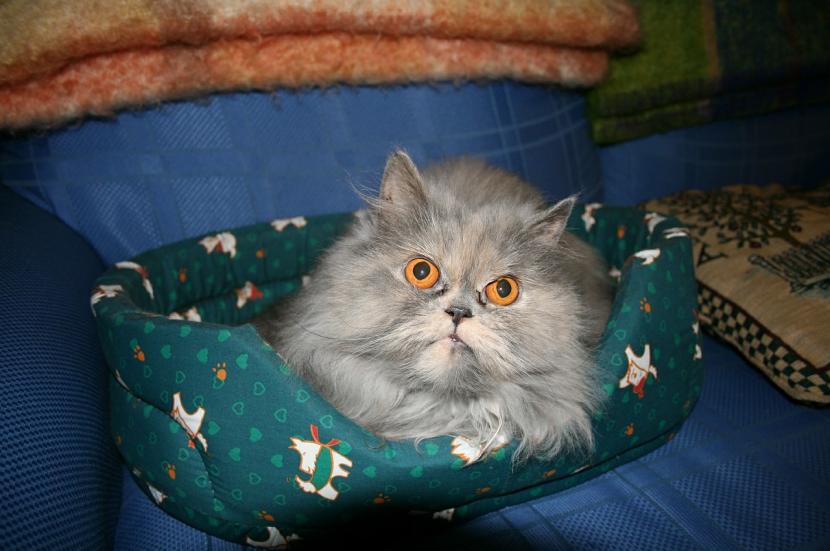
The Persian cat needs a series of care and attention to lead a full, happy life.
Hygiene
Hair
As he has long hair, it will be necessary that brush it at least once a day with a type of comb known as a card or, even better, with a FURminator, which is special for removing dead hair, very, very practical. During the warmer months, however, it will have to be brushed between 2 and 4 times a day, so not only will it stay a little cooler, but we will also prevent the house from getting too hairy 🙂.
Eyes
Must clean his eyes daily, since they usually present lagañas and lacrimation. To do this, we will use feminine make-up removal cotton that we will moisten in warm water. Afterwards, we will clean the eyes carefully, and we will dry it with another -dry- cotton.
Ears
We will clean them once a day with special wipes that you will find in veterinary clinics or pet stores. It will be necessary to pass them only through the auditory pavilion, that is, through the outermost part of the ear; never inside.
Can you bathe?
Of course. The ideal is get used to it since childhood, as it will take less time to get used to, like this stuffed animal:
How to get used to the bathroom
To make the bath a pleasant moment for him, we will put a low tray with warm water (neither too cold nor too hot) inside the bathroom, and we will encourage him to come over with a piece of food that he loves. Surely it will approach you fast, so when it does, give him lots of pampering and his food as soon as he gets close to the tray. At the moment, we will not bathe him, we just want him to associate the water tray with something positive.
For about 5-7 days, we will continue doing the same, and from the eighth day we will be able to take a little water from the tray and pour it carefully over it, like "the one who does not want the thing". It is likely that he will be surprised, or scared, but if he stays in the same place, let him compose himself from the shock and, when he has achieved it, give him a prize (cat treat, petting).
The next day we can start putting the cat in the bathtub, as long as we feel calm and we see that the furry does not dislike being in the bathroom.
How to bathe him
Before putting it in the bathtub, we have to prepare everything we will need: shampoo and conditioner for cats, towel, dryer and then fill the bathtub with lukewarm water (about 2-4cm). You got it? Then get to work:
- We will rinse the cat well, except the face, holding it by the back (firm, but soft, without hurting it)
- We will apply shampoo all over the body, performing a little massage until foam is created.
- We will clarify, removing all the remains.
- We will apply conditioner, as we did with the shampoo, and we will let it act for a maximum of 2 minutes.
- We will clarify one last time, and we put it on a towel.
- Le we dry well the hair with the dryer. By the way, it is highly recommended to use a professional one, since it allows us to manipulate the cat better. Another option is for one person to hold the cat, while another is in charge of drying its hair. Be very careful with the air temperature of the dryer: if it is too hot, we can harm the cat.
- Once dry, we will comb, starting with the neck area, passing through the neck and the body, until reaching the back.
Care
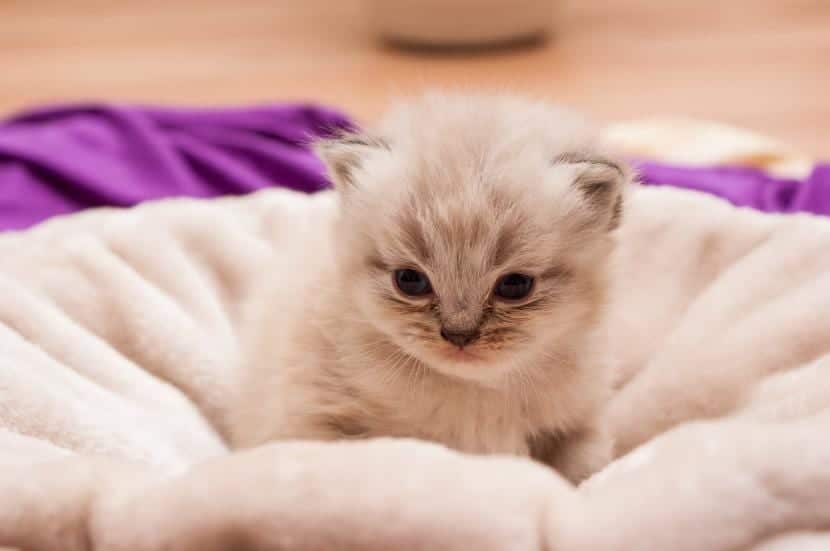
Like any other cat, we have to take care of it. This means that we have to provide you with everything you need to make your life with us as good as possible.
Food
We will start with the basics: food. You can give your cat three types of food: dry food, wet food (cans), or natural food. Let's see the advantages and disadvantages of each of them:
I think dry
It is the type of food that is sold the most, because it is really comfortable for us. However, there are many brands and new ones appear from time to time, so it will depend on the money we want / can spend choosing one or the other. What I do advise is that you give it a good quality feed, as current and future health will largely depend on it. Thus, the feeds that have a 70% minimum meat and the rest vegetables will be the most suitable. These will keep the coat soft and shiny, healthy and strong teeth, in short, you will have a healthy cat.
The only downside is that they have very little humidity (less than 20%), and since cats do not drink much water, it is worth giving them a can from time to time, especially in summer when they drink even less.
I think wet
The wet feed is one that has a minimum of 80% humidity. It is also quite comfortable, as you only have to open and serve. But they have a very important drawback and that is that we can't leave the trough full all day it would attract flies, ants and any insects that might be around the house. In addition, the price is somewhat higher, so more is usually given as a reward.
I also recommend looking for one of quality, which has a high percentage of meat, so that the cat's body remains healthy throughout its life.
Natural food
This type of food is the most suitable for all animals, including of course Persian cats. They can be given the meat of chicken thighs and other meats (always boneless), liver, heart, fish (without bones), and vegetables such as parsley or thyme. Before giving it, put it in a pot until the water starts to boil so that it can be cleaned well.
Giving them natural food is more expensive than feeding them and requires more preparation time, but what you spend on food ... you save on veterinary expenses, so in the end it pays off.
Vaccines
It is mandatory that you give him the following vaccines so that his immune system remains strong to be able to face possible infections:
- At 3 months: feline trivalent, which protects against viral rhinotrachetitis, panleukopenia and calcivirus.
- At 4 months: against feline leukemia, and a second dose of trivalent.
- At 5 months: third and last trivalent dose.
- At 6 months: against rabies.
- Once a year you will need to be vaccinated against rabies again.
Remember that before vaccinating, it must be dewormed.
Persian cat deworming
There are several ways to deworm a cat: with pills, pipettes, with sprays or with natural remedies.
- Tablets: They serve to eliminate intestinal or external parasites. In the case that they are to eliminate or fight the worms, it is necessary to give one every 3 months; and if they are for fleas and / or ticks, it will be one per month.
- Pipettes: they are very effective. They are applied to the back of the neck, right in the center, and it protects you against insects for a month.
- Spray: the cat is sprayed with them, as many times a month as you like, taking care that it does not reach the eyes, ears or mouth.
- Natural medicine: like giving him a bath with water and lemon, or adding a small spoonful of brewer's yeast to his food, will keep parasites away from your furry dog. On this article you have many more natural remedies to eliminate fleas in cats.
Other cares
The Persian cat is a furry cat who loves company. He will enjoy being by your side, either watching television or waiting for you to finish your tasks. In addition, he gets along very well with children, especially if they have a calm character. And, like any cat, there is nothing he likes more than they pay attention to him and take care of him as it deserves. Thus, it is important that:
- Let's put a litter box for him in a room where he can't be disturbed, with a clumping sand that does not dirty their feet. I recommend the one that is sand (gravel type) that is mixed with betonite, or that of silica. Its price is somewhat higher than that of other arenas, but having a single cat can give you 2-3 months, if not more.
- Having a flat face, it is very important that we give it a ball drinker (for rabbits). At first it is normal that you do not know how it works, so it will be up to us to teach you. You can pass him a piece of York ham for example so that he perceives the smell and wants to taste it.
- We will buy you several beds since it is more than likely that you do not want to sleep only in one. Thus, you can put one in the bedroom, a scraper with a bed in the living room, and another in the living room. And don't forget the blankets to cover the sofa or armchairs.
- Let's spend some time each day (ten minutes about 3 times / day) to play with him, since although it is true that it is a rather sedentary cat, it needs to feel part of the family, it needs to have fun with us. In the market you will find countless toys for cats (balls, mice, stuffed animals ...), but punch holes in a cardboard box and you will see how much fun it is, or encourage it to try to get a rope.
- Whenever we see that he is not feeling too well, we must take him immediately to the vet.
Diseases and health problems
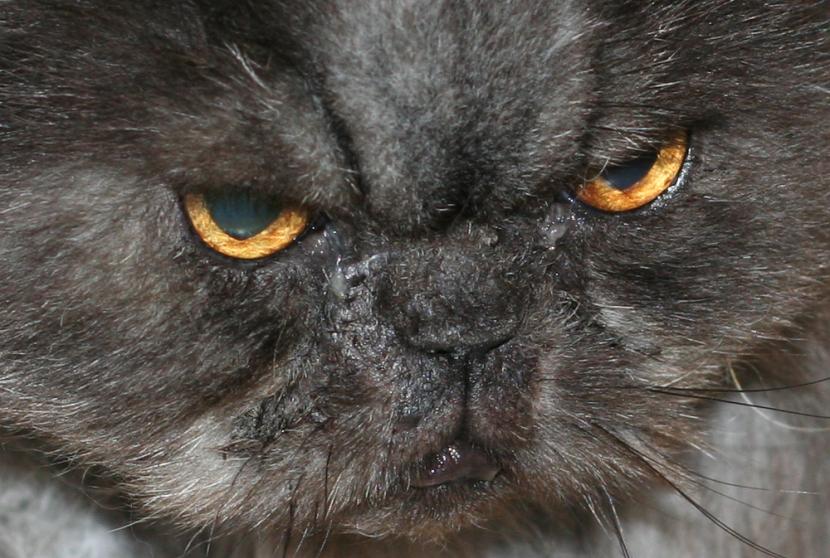
The Persian cat is a stuffed animal that unfortunately has diseases that we could classify as belonging to the breed. The selection and breeding of these felines have meant that we currently have to face a series of problems that can harm them. Let's know what we have to stick to:
Problems due to the shape of your face
By having a flat face, with a pressed nose, your tear ducts continually secrete and stain the skin under your eyes, which can cause skin ulcers. In addition, the eyelashes and hair on the nose can rub against the eyes, and their small nose can cause them respiratory problems.
The bad bite, or malocclusion, it is very common in these cats. Not to mention that, due to the altered shape of their head, females have difficulty giving birth.
Hypertrophic cardiomyopathy
This disease causes a enlargement of the left side of the heart, and can lead to the unexpected death of the animal. They suffer from it between a 9 and 10% of Persian cats.
Oily seborrhea
It consists of having the greasy, flaky skin.
Oculocutaneous albinism
Also called Chediak-Higashi syndrome, it is caused by a recessive gene that causes hair is lighter than normal. It causes photophobia and a tendency to bleed.
Tear duct overflow
If your cat won't stop crying, you probably have an overflowing tear duct.
Congenital hookworm
It occurs in blue Persian cats. Consists of the union of the two eyelids (lower and upper) by a membrane.
Urinary stones
What we all know as stones are very common in Persian cats, especially in obese ones. When they are too big they have to be extracted through surgery.
Hip dysplasia
When the joint slips out of the socket, it causes trouble walking.
Polycystic kidney disease
It affects more than a third of Persian cats. Consists of the appearance of multiple cysts in the kidneys, which cause an increase in them.
Patella luxation
May cause limp.
Skin fold dermatitis (of the face)
Due to the overflow of the tear duct, it is common for you to have dermatitis.
Hair balls
With long hair, they need to be brushed often to reduce the risk of hairball problems. They can cause them a lot of discomfort, such as constipation or vomiting and nausea. Proper brushing and a quality diet will largely prevent your Persian cat from swallowing an excessive amount of hair.
Curiosities of the Persian cat
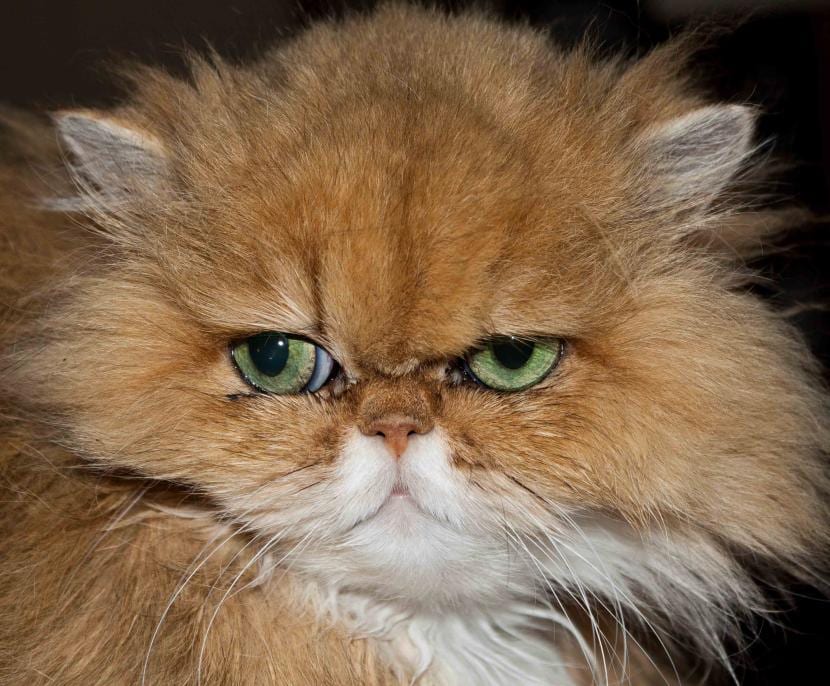
Now that we know everything about the Persian cat, there is still something else I want to tell you: its curiosities.
Aristocratic past
To speak of the Persian cat is inevitably to speak of the aristocracy. Queen Victoria of England (1837-1901) was one of his great admirers. Today they occupy the first positions of the feline pedigree worldwide.
About the fur
This is a cat that has always been related to royalty, and it is that has a longer and softer coat than other cat breeds. When you touch it, you immediately think that you have some cotton in your hands, and not a cat. But remember that you should brush it daily to keep it healthy and shiny.
Life expectancy
These cats live around 20 years. Two decades of pampering, caressing and delicious food!
Is it indoor or outdoor?
Well, I do not like to classify cats that way, because after all we are talking about animals that have been designed by nature to hunt. Now, from the Persian we could say, and we would not be mistaken, that it has been created by the human being, so even though it still has the body of a cat, due to its flat face could have a lot of trouble living abroad. And in fact, I don't think anyone would consider leaving their furry out of the house and being able to have him on the couch, right? 🙂
The loot is ... a Persian cat
European explorers brought from Persia (what is now Iran) food, spices, jewelry ... and Persian cats as loot smuggled.
The famous cat
There are many celebrities who have a Persian as a furry friend. Between them, Kim Kardashian o Giorgio Armani.
They say they love compliments
To the point that they are even more affectionate. Is it true?
Beware of excesses
Especially after sterilization, you have to control well what you eat, because obesity is very dangerous in these cats, and can even cause fractures in their legs.
Persian cat »peke-face»
The peke-face is a variant of the Persian cat, which originated from a recessive gene. They have a very flat muzzle, and their nose is closer to the eyes, which can cause breathing or tearing problems.
Very small litters
Unlike other cats, which can have up to 10 young, Persians only have a maximum of 3.
Sale / Prices of the Persian cat
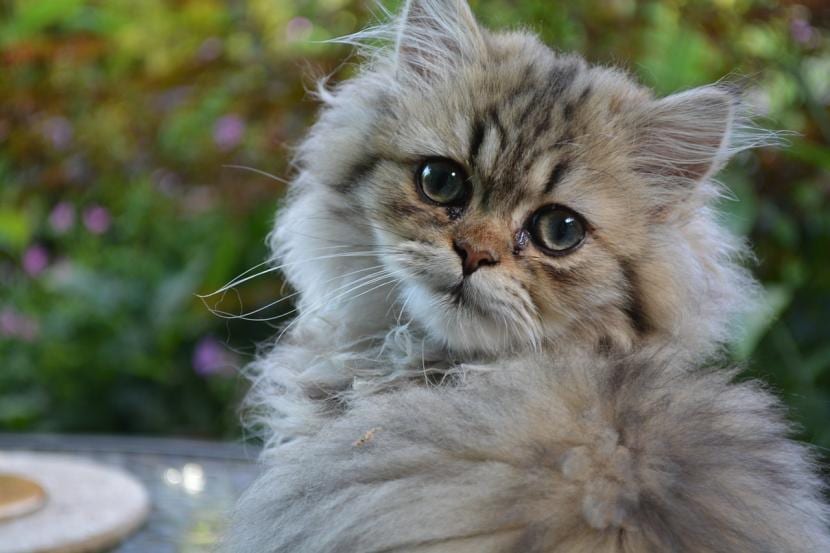
If you are thinking of buying a Persian cat we could not finish this guide without giving you some tips so that your purchase is the most successful.
Where to buy
Internet
At present you can find advertisements for the sale of cats of this breed on any page: Thousand Ads, Second Hand, cattery pages and also in specific forums. But, How can i be sure i'm not being cheated on?
Do you understand the language?
Well, the first thing is to check what language they speak. It may seem silly, but it is easy to meet people who simply write a text in their mother tongue, translate it with a translator, and put that text on web pages. Web translators are not exact, and they make quite a few mistakes. If that text seems to be, for example, in Spanish, but it has words that you don't understand and are written in the wrong order, be suspicious.
A purebred kitten is never free
This is important to keep in mind. When looking for a purebred cat, whatever it is, that is very young (between 2 and 4 months old), they will always want to sell it.
Contact details
The person who sells animals must have included their contact information (at least, the mobile phone number). If it is a kennel, in addition, it must have specified the postal address, zoo nucleus and email.
Photos, the more the merrier
You, as a potential buyer, You have every right to request how many photos and videos you want. If at any time you perceive some distrust on the part of the seller, look for another.
Are you in too much of a hurry?
When a salesperson seems to be in too much of a rush, or wants to sell you a kitten less than 2 months old, distrust. A cat should never be separated from its mother so soon. It is much more advisable to wait until it is at least 8 weeks old, since this way both its mother and its siblings will have taught it the basics of being a cat.
Pet shops
In pet stores, they usually have cats of different breeds, and if they don't have the one you are looking for, they will order it. But what about these places? Well sadly most of the animals sold here are the result of a massive breeding from eastern countries. Mothers live in cages their entire lives, and only give birth over and over again. Kittens that come to the store alive tend to have many health problems both in the short and medium term.
So, if you want to buy one in store, ask the exact origin of the kitten. They should have no qualms about showing you the animal's provenance papers.
Hatcheries
The Persian cat is one of the oldest breeds in the world, so you will surely find a kennel near you. However, it is worth visiting several to compare them.
A good cattery will have:
- The facilities in good condition
- Drinkers with fresh and clean water
- Clean trough with food
- Hygienic trays with clean sand, no bad odors
- Well-groomed cats, with shiny coats and a desire to play, healthy
- The parents of the offspring will have registered with a pedigree association (CFA, TICA, WFC ...)
And of course, it will solve all your doubts that you have while letting you be with the puppies so that it is easier for you to choose one.
If you buy him a cat, he will provide you with the pedigree with the owner transfer sheet when he gives it to you. In the event that you have not registered, they will not be able (only breeders can) register your furry in any association.
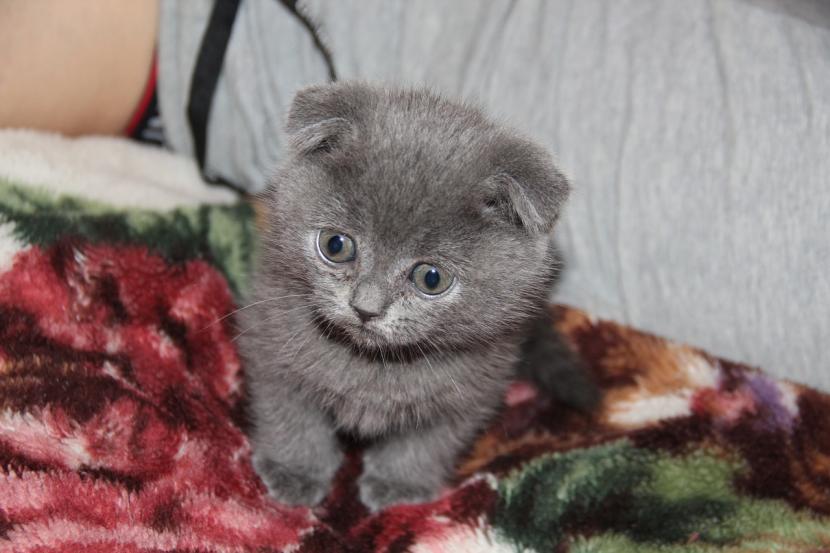
Private Customers
It does not usually happen, but from time to time there is an individual whose cat has raised and wants to sell the offspring. Well, it is as good a way as any to get a Persian cat, as long as it allows you to come to his house to see them, and do not give them when they are less than two months old.
Health status of the offspring
Regardless of where you buy your Persian cat, this one must show the typical puppy character, that is, it has to:
- Be active
- Wanting to play with his siblings and with his mother
- Be curious about the people who visit you
- Be in good health (white teeth, no traces of diarrhea or bad breath, open eyes, no lameness)
- The coat must be brushed, without knots
Persian cat prices
Persian cat prices can vary quite a bit. In a pet store they can cost around 200 euros, but they give them to you without pedigree and without any certificate confirming that it is purebred. Individuals usually sell kittens for those prices too, so it is wise to think carefully about where you want to get your Persian from.
However, in a professional breeder, they will ask you 700 euros for one you want as a "pet", which they will give you already sterilized, or 900 if you want it to reproduce it. It is quite more expensive, but This way you make sure that you take home a healthy cat, with the pedigree papers and the tests if they have done any, and knowing the parents.
Adopt a Persian cat
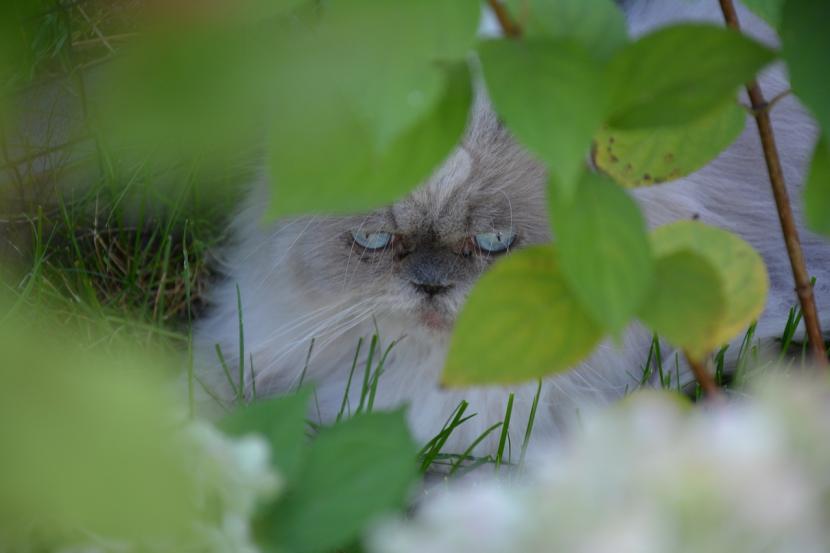
It is not often that cats of this breed are abandoned, but in shelters and animal shelters you sometimes find them. These cats are now adults, who for one reason or another have ended up in these places. If you are looking for a friend forever and you do not mind that he does not have a pedigree, take a tour of the shelters or protectors in your area. It is very likely that a Persian cat is waiting for you.
So far this mega-guide to one of the most popular cat breeds: the Persian cat. We hope it has been useful to you and, if you dare to live with one of these furry friends, just congratulate you for the decision. You will take home a lovely animal 🙂.
Enjoy your company!
I bought my cat from a private individual and from my experience I want to add that you have to look for fleas and pink gums, because if it has white it means that it has anemia. They gave me anemic because of the fleas and I had to take him to the vet running, luckily now he is healthy but if I had known, I would have noticed the first day.